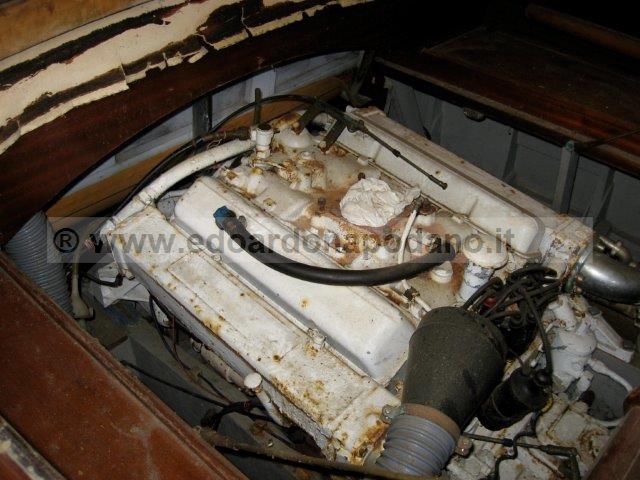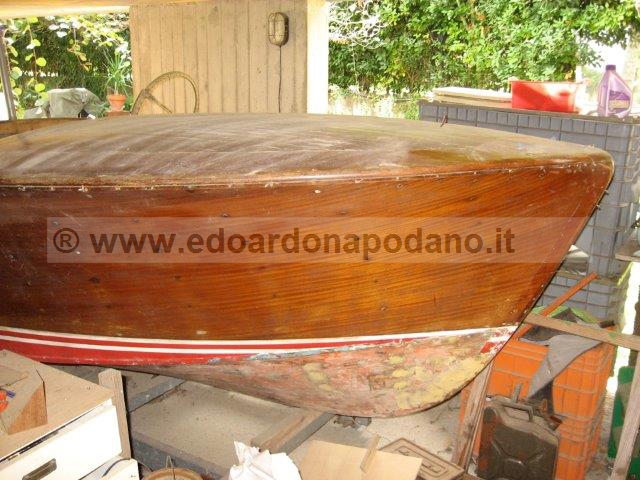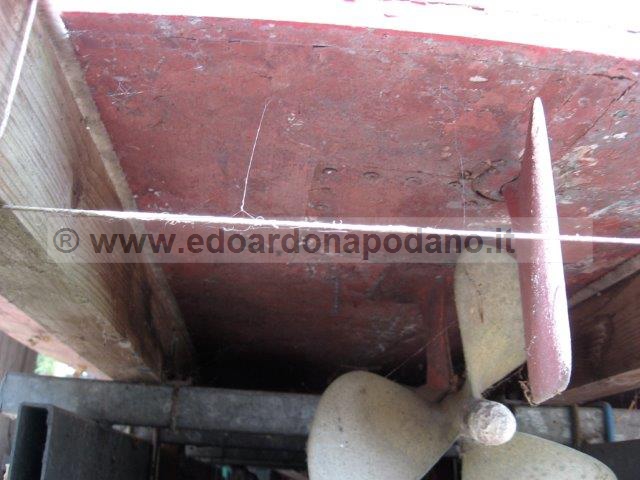Riva Florida 1963
Chris Craft 283H V8
many photo on request
molte foto disponibili su richiesta
there are all the equipment, accesories, metallic parts not visible from the pics
Chris Craft 283H V8
courtesy RHS
“Il Florida nasce allungando il disegno del Sebino, con coperta in massello Honduras filettato di acero nelle giunzioni, con il parabrezza in cristallo, in due parti, con sedili e fianchetti laterali in vipla verde imbottita e materassino prendisole in tela verde trapuntata. Gli strumenti di controllo sono americani (S.W./Chris Craft) a fondo nero. Le tasche laterali portaoggetti sono in rete di ottone cromato. Con la serie 1953 il parabrezza è a vetro unico (la produzione delle serie inizia dopo l’estate dell’anno precedente a quello di riferimento). Nel 1955 vengono adottate le stesse modifiche indicate per il Sebino (ordinate a 16 cm., parabrezza unico, fasciame applicato con l’ausilio di collanti, nuova scatola sterzo, viti con testa a croce per la carena, alberi in Monel metal). Le tappezzerie sono ora in vinilpelle e Saran a disegno scozzese verde. Con la serie 1957 la coperta è in Honduras lamellare con filetti di acero. Con la serie 1958, primo al mondo, Riva adotta le murate lamellari a triplo fasciame, sagomate in un pezzo unico. Il parabrezza è ora panoramico in cristallo Visaterm. La serie 1959 presenta un nuovo disegno del cruscotto, che adotta i nuovi strumenti (S.W./Chris Craft) dal # 288 del 1958, tasche laterali in legno sagomato, tappezzeria in vipla gialla e saran a quadrettini bianchi e neri al posto dello scozzese verde. Il materassino prendisole è in tela makò gialla. Nel 1960 il Florida monta il nuovo volante a calice, già montato sugli altri modelli; il serbatoio è ora in acciaio inox con capacità di 100 litri invece di 90. Sul cruscotto compare la scritta ”Florida” al posto di ”Riva Chris Craft”. Dal 1960, su tutti i modelli, le viti hanno la testa a croce anche per il fissaggio delle modanature cromate. Nel 1961, con l’adozione del nuovo motore 8V Chris Craft, depotenziato da 185 Hp. a 4000 giri a 160 Hp. a 3600, dotato di invertitore idraulico, la leva di comando d’inversione è portata al volante. Si passa, inoltre, dall’impianto elettrico a 6 volt a quello a 12 volt. Lo scafo viene leggermente modificato in carena, in corrispondenza della sezione maestra, per addolcire l’impatto sull’onda, è allungato di 9 cm. e lo specchio di poppa è ora arrotondato perchè costruito in lamellare sagomato. L’elettro-sirena è ora di serie. Nel modello 1963 viene aumentato lo slancio di prua di 7 cm. e le difese cromate di prua sono più lunghe di 25 cm.”
The Florida was created by lengthening the design of Sebino, with decking of solid Honduras filleted with maple at the seams, with a two-part glass windscreen, with seats and side panels of padded green Vipla and a quilted green fabric sunbed. The instruments were American (S.W./Chris-Craft) with black faces. The side pockets were of chrome-plated brass netting. With the 1953 series the single piece windscreen starts (series production starts in the autumn prior to the year of reference). In 1955 the same modifications as mentioned for the Sebino were adopted (timbers at 16 cm, planking fastened with the aid of adhesives, new steering box, Phillips screws for the bottom and Monel shaft). The upholstery was now of leatherette and Saran with a green tartan pattern. With the 1957 series, the deck was of Honduras ply with maple fillets. With the 1958 series, Riva was first in the world to use three layer diagonal planking for the hull sides shaped in a single piece. The windscreen was now panoramic of Visaterm glass. The 1959 series presented a new dashboard design that used new instruments (S.W./Chris-Craft) from # 288 of 1958, shaped wood side pockets and upholstery of yellow Vipla and black and white check Saran in place of the green tartan. The sunbed was of yellow Makò fabric. In 1960 the Florida was fitted with the new deep-centre wheel, already fitted to the other models and the fuel tank was now of stainless steel with a capacity of 100 litres instead of 90. The text ”Florida” appeared on the dashboard instead of ”Riva Chris-Craft”. From 1960 Phillips screws were also used on all models for fixing the chrome plated deck fittings. In 1961, with the adoption of the new Chris-Craft V8 engine with power reduced from 185 Hp at 4000 rpm to 160 Hp at 3600, the gear lever was moved to the wheel. The electrical system was also changed from 6 volts to 12 volts. The hull bottom was slightly modified at the midship section to soften impact with the wave and the hull was lengthened by 9 cm. The transom was now made of three layer diagonal planking and was curved. An electric siren was now standard. In the 1963 model the rake of the bow was increased by 7 cm and the chrome plated cutwater was 25 cm longer.





